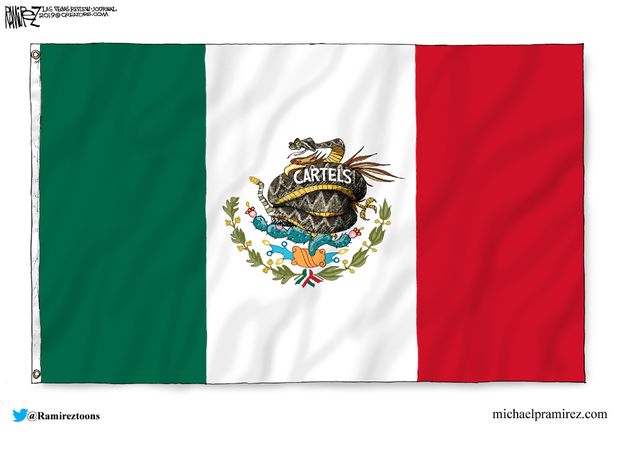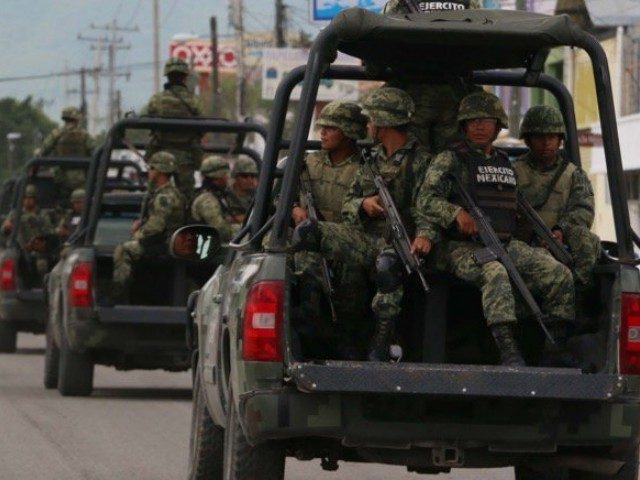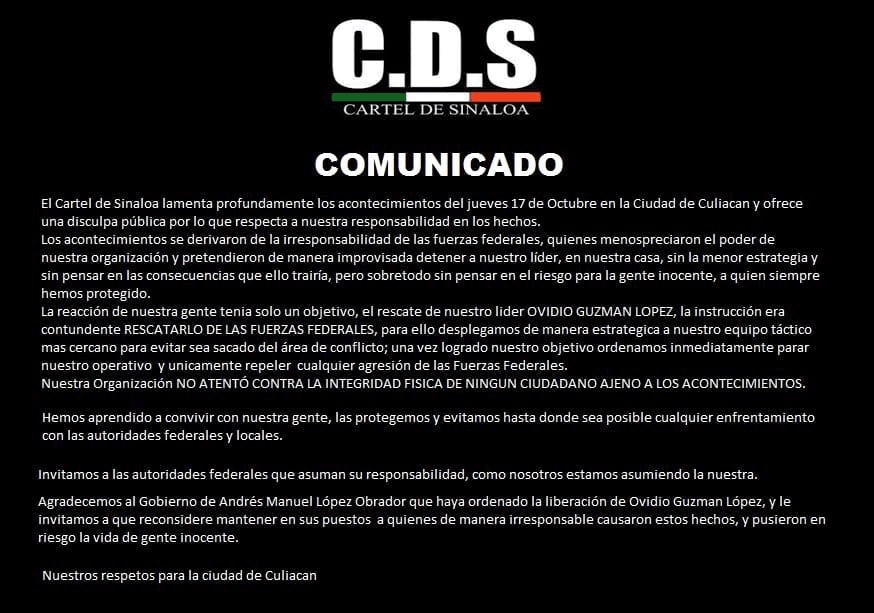
Mexican Cartels Are Winning the Propaganda War

5:18
Cartels repeatedly demonstrate their capabilities as effective propagandists against the general public, rivals, and even layers of Mexican or international governing bodies. Their practices try to blur the lines between criminality, terrorism, and even righteous insurgency — raising red flags for national security.
Though typically unrealized, many Mexican cartels manage their organizations like large corporations complete with accounting, legal, and public relations departments. It is common for members to refer to their groups as a “companies.” Simply referring to them as “drug cartels” minimizes their impacts on life and culture south of the border and beyond.
News Media
Dedicated propaganda cells traffic in all forms of new and old media outreach. They place vinyl banners on government buildings, bridges, overpasses, and monuments. In one instance, they even dropped leaflets from an airplane reminiscent of psy-ops efforts prior to a military invasion. They also use social media to disseminate graphic torture footage to catch the attention of international journalists. Every message is designed to either threaten rivals, defend its actions, or even promote good deeds for the benefit of the civilian population living on their turf.
Mexican journalists also walk a tightrope when attempting straight coverage of cartel exploits. Such work in Mexico is some of the most dangerous in the world. In 2019, nearly 250 cases of violence directed at media personnel in the country were documented. Investigative reporters willing to dig into cartel and government connections are particularly at risk.
These organizations do not circulate press releases and hope for glowing coverage. Many Mexican newsrooms are compromised to the point that a particular cell will be in constant contact to act as a de facto assignment editor – deciding which unflattering stories go unpublished versus items that make rivals look bad in the public eye. Failure to cooperate too often means death.
In the Streets
Cartels are bold in their efforts to secure the hearts, minds, and especially stomachs of those living impoverished lives around them. During high holidays, cartel gunmen will lay down arms in public squares to distribute toys or food as if they were the Red Cross. Recently in Michoacán, Cartel Jalisco New Generation (CJNG) posted a video distributing food to the poor. In Tamaulipas, the Gulf Cartel hands out Christmas gifts annually near the Texas border. Gunmen even manage to use local radio stations to promote their charitable acts. During Hurricane Ingrid in 2013, convoys of vehicles were used to distribute tons of food and supplies.
Music and Memes
Popular culture is also leveraged directly and indirectly to idealize the cartel lifestyle. Folk music dubbed “narco-corridos” promote bravery, riches, and sex surrounding the traffickers. Groups will even single out singers praising a rival faction for death. One music video uploaded to YouTube in 2013 promotes the Sinaloa Cartel by mixing staged and actual footage from sicarios.
Gunmen may even dabble in viral dance video challenges in full tactical gear.
Protests and ‘Human Rights’
Mexican organized crime can also wield influence over international bodies like the United Nations. The Cartel del Noreste (CDN) faction of Los Zetas developed efforts to astroturf street protests against police forces near the Texas border in Nuevo Leon. They worked to gin outrage against authorities as top-level operatives were targeted for arrest. Some entities are bold enough to cooperate with “human rights” groups to disseminate conspiracy theories against local governments. In May 2018, the UN issued accusations against federal authorities, suggesting they were abducting CDN members.
Attorneys and Spokesmen
Cartels are comfortable using attorneys for public means. No cartel is complete without a lawyer.
In the aftermath of the high-profile arrest and abrupt release of El Chapo’s son, Ovidio “El Raton” Guzman, multiple attorneys in Mexico and the United States were deployed to spin and play damage control. They held news conferences and sat for interviews to praise President Andres Manuel Lopez Obrador’s (AMLO) actions. They also congratulated themselves for their public works on behalf of the Mexican people. One spokesman even explained the Sinaloa Cartel’s plans to build a university, inviting AMLO to attend the first stone laying with El Chapo’s mother. Attorneys also drew a line between the AMLO administration’s decision to release the “Chapito” while condemning those in law enforcement who were responsible for the arrest.
Days later, the Sinaloa Cartel released a branded public apology, which in turn placed much of the blame on federal forces for sparking terror in the state. They go on to thank AMLO for releasing their leader and encouraged authorities to “assume their responsibilities as we are assuming ours.”
New York-based attorney Jeffrey Lichtman, who represents convicted “El Chapo” Guzman, told PIX 11 “I don’t know what caused this, we don’t even know who was shooting the guns.” He also expressed discomfort with taking claims from Mexico City and Washington officials “as Gospel.”
Mexican cartels are perfecting the art of modern persuasion to threaten rivals with demonstrable violence while, in the same breath, suggesting such actions are in the public interest. Their messages can appear from an overpass during the morning drive and in a Twitter feed before turning off a nightlight. Their influence is seen in the local newspaper and on an FM dial. When innocents are objectively terrorized or harmed, a cleanup crew featuring fixers and charitable gestures follow. Until these sophisticated measures are understood and confronted on a critical scale, cartel control will continue to expand unabated.
Jaeson Jones is a retired Captain from the Texas Department of Public Safety’s Intelligence and Counterterrorism Division and a Breitbart Texas contributor. While on duty, he managed daily operations for the Texas Rangers Border Security Operations Center.
Mexico Now Says Different Cartel Responsible for Mormon Family Murders

2:46
Mexican security officials leading the investigation into the mass murder of nine Mormons in Sonora say the victims were likely mistaken for a rival cartel convoy. They also believe the Juarez Cartel–not the Sinaloa Cartel–is now to blame.
On Monday, a group of cartel gunmen shot and killed three women and six children as they were driving in the mountainous region between the Mexican border states of Sonora and Chihuahua, just south of the New Mexico boot heel. Authorities revealed they collected more than 200 rounds of spent .223 ammunition casings at the scene of the attack.
During a press conference on Wednesday morning, Mexican Army General Homero Mendoza said that earlier in the day of the incident, gunmen from the Sinaloa Cartel faction “Gente Nueva de Los Los Salazar” clashed with rivals from “La Linea,” the enforcement wing of the Juarez Cartel, based in the border state of Chihuahua.
The clashes took place in Agua Prieta, Sonora, when authorities received information on various skirmishes between La Linea and Los Salazar shortly after 3:15am local time. Three hours later, authorities responded to another incident at a funeral home in Agua Prieta.
After attacking the Sinaloa Cartel turf, La Linea took a series of defensive measures to keep rivals from entering Chihuahua for payback, Mendoza said in reference to a working theory on the case.
“[La Linea] placed a cell between the towns of Janos and Bavispe in the border of both states (Sonora and Chihuahua). It is assumed they sent it to stop any penetration by Los Salazar and it is assumed that this group is the one that took part in the aggression against the LeBaron family,” the general added.
The working theory is that since members of the LeBaron family were moving in four large SUVs, gunmen mistook them for a rival convoy, the general said.
“The types of vehicles they used, Suburbans, are commonly used by organized crime members moving along the mountain region,” Mendoza said.
On Tuesday afternoon, Chihuahua Attorney General Cesar Augusto Peniche claimed the likely suspects were the “Jaguares” cell within the Sinaloa Cartel since they control Agua Prieta. He said the Jaguares were at odds with La Linea and Cartel Jalisco Nueva Generacion (CJNG).
Ildefonso Ortiz is an award-winning journalist with Breitbart Texas. He co-founded Breitbart Texas’ Cartel Chronicles project with Brandon Darby and senior Breitbart management. You can follow him on Twitter and on Facebook. He can be contacted at Iortiz@breitbart.com.
Brandon Darby is the managing director and editor-in-chief of Breitbart Texas. He co-founded Breitbart Texas’ Cartel Chronicles project with Ildefonso Ortiz and senior Breitbart management. Follow him on Twitter and Facebook. He can be contacted at bdarby@breitbart.com.
MEXICO KILLS AMERICA TWICE OVER!
DHS Secretary: ‘ICE Interdicted Enough Fentanyl Last Year to
Kill Every American Twice Over’
https://mexicanoccupation.blogspot.com/2019/03/dhs-secretary-ice-interdicted-enough.html
*
“Mexican Border States Net 320 Pounds of Meth in Two Days” BREITBART
*
“Eight-Time Deportee Accused of Trafficking $850,000 in Meth, Cocaine.”
MICHAEL CUTLER
JUDICIAL WATCH:
“The greatest criminal threat to the daily lives of American citizens are the Mexican drug cartels.”
“Mexican drug cartels are the “other” terrorist threat to America. Militant Islamists have the goal of destroying the United States. Mexican drug cartels are now accomplishing that mission – from within, every day, in virtually every community across this country.” JUDICIALWATCH
NARCOMEX PRESIDENTS SUCK IN STAGGERING BRIBES FROM LA RAZA HEROIN CARTELS
"While other witnesses at Mr. Guzmán’s trial in Federal District Court in Brooklyn have testified about huge payoffs from traffickers to the Mexican police and public officials, the testimony about Mr. Peña Nieto was the most egregious allegation yet. If true, it suggests that corruption by drug cartels had reached into the highest level of Mexico’s political establishment."
https://mexicanoccupation.blogspot.com/2019/01/el-chapo-trial-formermexican-president.html
The former president of Mexico, Enrique Peña Nieto, took a $100 million bribe from Joaquín Guzmán Loera, the infamous crime lord known as El Chapo, according to a witness at Mr. Guzman’s trial. ALAN FEUER
HIGHLY GRAPHIC!
IMAGES OF AMERICA UNDER LA RAZA MEX OCCUPATION… gruesome!
http://mexicanoccupation.blogspot.com/2013/10/america-la-raza-mexicos-wide-open.html
BEHEADINGS LONG U.S. OPEN BORDERS WITH NARCOMEX: The La Raza Heroin Cartels Take the Border and Leave Heads
HIGHLY GRAPHIC VIDEO!
LA RAZA DRUG CARTELS CUT OUT HEART OF LIVING MAN.
*
MARK LEVIN:
‘THERE IS A BIG, UGLY SIDE TO ILLEGAL IMMIGRATION
NARCOMEX DRUG CARTELS OCCUPY
TEXAS
MCALLEN, Texas -- The capture of three top Mexican drug cartel bosses on the U.S. side of the Texas border helps to illustrate the irony of how even narco's seek refuge from the violence in Mexico.
LOS ANGELES – GATEWAY FOR THE LA RAZA MEX DRUG CARTELS
NARCOMEX in LA RAZA-OCCUPIED LOS ANGELES – Western gateway for the MEXICAN DRUG CARTELS and MEXICO’S SECOND LARGEST CITY.
Federal agents raided Q.T Fashion and numerous other businesses in the downtown fashion district Wednesday, cracking down on a scheme that cartels are increasingly relying on to get their profits — from drug sales, kidnappings and other illegal activities — back to Mexico, authorities said.
Nine people were arrested in raids targeting 75 locations, and $90 million was seized — $70 million in cash. In one condo, agents found $35 million stuffed in banker boxes. At a mansion in Bel-Air, they discovered $10 million in duffel bags.
"Los Angeles has become the epicenter of narco-dollar money laundering with couriers regularly bringing duffel bags and suitcases full of cash to many businesses," said Robert E. Dugdale, the assistant U.S. attorney in charge of federal criminal prosecutions in Los Angeles.
THE LA RAZA MEXICAN DRUG CARTELS REMIND AMERICANS (Legals) THAT THERE IS NO (REAL) BORDER WITH NARCOMEX!
SHOCKING IMAGES OF CARTELS ON U.S. BORDERS:
“Heroin is not produced in the United States. Every gram of heroin present in the United States provides unequivocal evidence of a failure of border security because every gram of heroin was smuggled into the United States. Indeed, this is precisely a point that Attorney General Jeff Sessions made during his appearance before the Senate Judiciary Committee hearing on October 18, 2017 when he again raised the need to secure the U.S./Mexican border to protect American lives.” Michael Cutler …..FrontPageMag.com



No comments:
Post a Comment